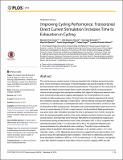| dc.contributor.author | Vitor-Costa, Marcelo | en_US |
| dc.contributor.author | Okuno, Nilo Massaru | en_US |
| dc.contributor.author | Bortolotti, Henrique | en_US |
| dc.contributor.author | Bertollo, Maurizio | en_US |
| dc.contributor.author | Boggio, Paulo Sergio | en_US |
| dc.contributor.author | Fregni, Felipe | en_US |
| dc.contributor.author | Altimari, Leandro Ricardo | en_US |
| dc.date.accessioned | 2016-01-04T19:23:15Z | |
| dc.date.issued | 2015 | en_US |
| dc.identifier.citation | Vitor-Costa, Marcelo, Nilo Massaru Okuno, Henrique Bortolotti, Maurizio Bertollo, Paulo Sergio Boggio, Felipe Fregni, and Leandro Ricardo Altimari. 2015. “Improving Cycling Performance: Transcranial Direct Current Stimulation Increases Time to Exhaustion in Cycling.” PLoS ONE 10 (12): e0144916. doi:10.1371/journal.pone.0144916. http://dx.doi.org/10.1371/journal.pone.0144916. | en |
| dc.identifier.issn | 1932-6203 | en |
| dc.identifier.uri | http://nrs.harvard.edu/urn-3:HUL.InstRepos:23993504 | |
| dc.description.abstract | The central nervous system seems to have an important role in fatigue and exercise tolerance. Novel noninvasive techniques of neuromodulation can provide insights on the relationship between brain function and exercise performance. The purpose of this study was to determine the effects of transcranial direct current stimulation (tDCS) on physical performance and physiological and perceptual variables with regard to fatigue and exercise tolerance. Eleven physically active subjects participated in an incremental test on a cycle simulator to define peak power output. During 3 visits, the subjects experienced 3 stimulation conditions (anodal, cathodal, or sham tDCS—with an interval of at least 48 h between conditions) in a randomized, counterbalanced order to measure the effects of tDCS on time to exhaustion at 80% of peak power. Stimulation was administered before each test over 13 min at a current intensity of 2.0 mA. In each session, the Brunel Mood State questionnaire was given twice: after stimulation and after the time-to-exhaustion test. Further, during the tests, the electromyographic activity of the vastus lateralis and rectus femoris muscles, perceived exertion, and heart rate were recorded. RM-ANOVA showed that the subjects performed better during anodal primary motor cortex stimulation (491 ± 100 s) compared with cathodal stimulation (443 ± 11 s) and sham (407 ± 69 s). No significant difference was observed between the cathodal and sham conditions. The effect sizes confirmed the greater effect of anodal M1 tDCS (anodal x cathodal = 0.47; anodal x sham = 0.77; and cathodal x sham = 0.29). Magnitude-based inference suggested the anodal condition to be positive versus the cathodal and sham conditions. There were no differences among the three stimulation conditions in RPE (p = 0.07) or heart rate (p = 0.73). However, as hypothesized, RM- ANOVA revealed a main effect of time for the two variables (RPE and HR: p < 0.001). EMG activity also did not differ during the test accross the different conditions. We conclude that anodal tDCS increases exercise tolerance in a cycling-based, constant-load exercise test, performed at 80% of peak power. Performance was enhanced in the absence of changes in physiological and perceptual variables. | en |
| dc.language.iso | en_US | en |
| dc.publisher | Public Library of Science | en |
| dc.relation.isversionof | doi:10.1371/journal.pone.0144916 | en |
| dc.relation.hasversion | http://www.ncbi.nlm.nih.gov/pmc/articles/PMC4687680/pdf/ | en |
| dash.license | LAA | en_US |
| dc.title | Improving Cycling Performance: Transcranial Direct Current Stimulation Increases Time to Exhaustion in Cycling | en |
| dc.type | Journal Article | en_US |
| dc.description.version | Version of Record | en |
| dc.relation.journal | PLoS ONE | en |
| dash.depositing.author | Fregni, Felipe | en_US |
| dc.date.available | 2016-01-04T19:23:15Z | |
| dc.identifier.doi | 10.1371/journal.pone.0144916 | * |
| dash.contributor.affiliated | Fregni, Felipe | |


